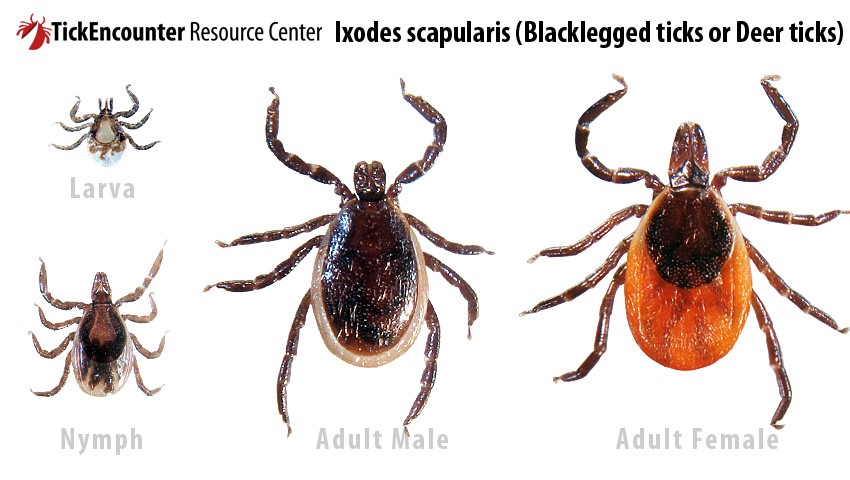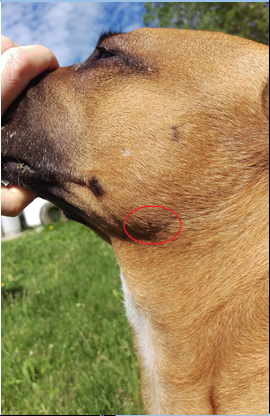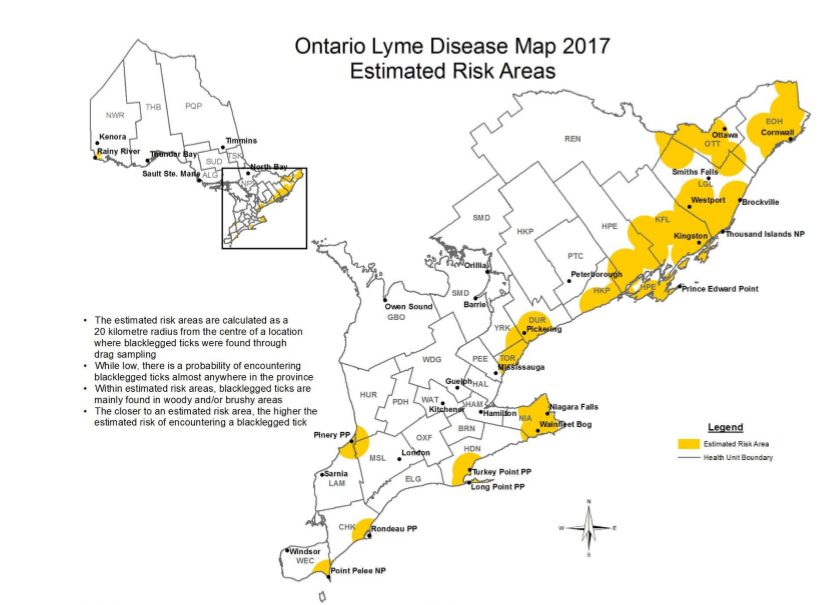Hi everyone, it has been a busy week at Hoosick Veterinary Clinic. For this week’s blog, I would like to talk about Lyme disease. Lyme disease is a commonly diagnosed disease in this area but not as common in some parts of Canada, including parts of Ontario. So, what is Lyme disease, who is at risk, and where are high risk areas in Ontario, Canada?
Lyme disease is caused by the infective spirochete agent Borrelia burgdorferi. The spread of the disease is facilitated by the Ixodes scapularis, more commonly known as deer ticks. These ticks are referred to as multi host ticks, meaning they feed once on multiple separate hosts. Larval and nymph stages feed on hosts which may result in infection with B. burgdorferi. The most common wild hosts are the white footed mouse which act as reservoirs for infection. It has been found that a greater proportion of female ticks are infected with B. burgdorferi than males. This is due to the increased feeding activity of females.
 Clinical presentation of the disease is fever, lethargy, depression, decreased or absent appetite, generalized pain, and pain associated with joints. Sometimes in animals, renal failure, neurologic dysfunction and heart disease can be seen. In horses, uveitis (inflammation of parts of the eye) can be seen. These conditions are uncommon but serious. In humans, a characteristic “bullseye” rash can be associated with the infection. This rash appears at the bite site in humans, but is not seen in animals. The main animal species clinically affected are: dogs, and horses. Without getting into too much detail let’s talk about risk factors.
Clinical presentation of the disease is fever, lethargy, depression, decreased or absent appetite, generalized pain, and pain associated with joints. Sometimes in animals, renal failure, neurologic dysfunction and heart disease can be seen. In horses, uveitis (inflammation of parts of the eye) can be seen. These conditions are uncommon but serious. In humans, a characteristic “bullseye” rash can be associated with the infection. This rash appears at the bite site in humans, but is not seen in animals. The main animal species clinically affected are: dogs, and horses. Without getting into too much detail let’s talk about risk factors.
Risk factors include being in an area with a high prevalence of Lyme infected ticks (such as north eastern states of the USA), tall grass/ wooded areas where ticks are often found, and not taking proper protective precautions.
How to Identify a Deer Tick:
 http://www.tickencounter.org/tick_identification/deer_tick
http://www.tickencounter.org/tick_identification/deer_tick
Let’s talk about what you can do to this summer to keep you and your pets safe!
Talk to your veterinarian about your pet’s risk factors and determine the best tick prevention product. There are many products available in many forms including: collars, spot on topical, and oral medications. Follow the label directions provided and give the treatment as often as directed throughout tick season. Ticks are out when it is above freezing in the spring and until the first few hard frosts in early winter. For Ontario, tick season is April to December in general. But remember adults are out whenever it is above 7 degrees C. Also, don’t forget to protect yourself. If going out; wear pants, tuck the bottoms into your socks and apply tick repellents.
Start preforming tick checks on your pets and yourself every time you come in from outdoors. Common areas ticks like to burrow are: around the ears, under the chin, neck, and axilla (armpits). Uncommon areas include gums, nose, and in-between toes. Remember deer ticks are tiny, so take your time looking. To remove an embedded tick grab as close to the head of the tick as possible, and pull the tick straight out to remove it. Do not apply any topical products to the area to remove the tick. Commercially available tick removal tools are available to help you remove ticks. Inspect the tick and the area to ensure full removal. If parts of the tick are left in your pet’s skin, contact your veterinarian. Inspect the area where the tick has been removed for the next few days to ensure no local infection has begun. If you notice any of the following: redness, heat, swelling, discharge call your veterinarian.
 The photo on the left shows an adult male deer tick attempting to burrow into Leah’s fur.
The photo on the left shows an adult male deer tick attempting to burrow into Leah’s fur.
Multiple vaccines against Lyme disease is available for dogs. It is a series of two vaccines initially followed by annual vaccination. Your dog should be tested for Lyme disease prior to vaccination. Discuss your dog’s risk factors with your veterinarian to determine if the vaccine is appropriate for your pet.
If you are concerned that your pet is has Lyme disease a simple blood test is available. Contact your veterinarian to set up an appointment today. If your pet is diagnosed with Lyme disease don’t fret, it is a treatable condition. Most pets recover with prompt and full treatment. It is important to complete the whole prescribed antibiotic treatment. If your pet is experiencing any side effects from the antibiotic contact your veterinarian for further instructions. Remember have fun this summer and don’t forget to check for ticks!
Prevalence of Lyme Disease:
Each dot on the U.S. map below represents a diagnosed case of Lyme disease reported in people in 2015.
(From: (CDC 2015) https://www.cdc.gov/lyme/resources/reportedcasesoflymedisease_2015.pdf)

Ontario Lyme Disease Map 2017
The yellow areas represent areas of risk for Ontario Canada.
(From: http://www.publichealthontario.ca/en/eRepository/Lyme_disease_risk_areas_map.pdf)

